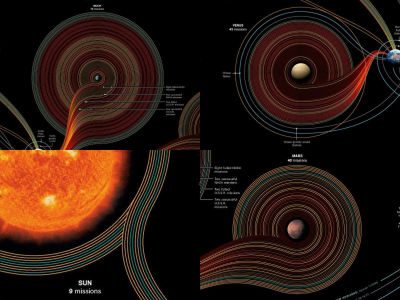Six points for 'long-term thinking' to protect the future for generations to come

“ Long-term thinking, ” which considers things for decades and even hundreds of years, is an important way of thinking in order to develop humankind and improve environmental problems. Philosopher Roman Kurznarik explains what to consider in order to judge things with long-term thinking.
Six Ways to Think Long-term: A Cognitive Toolkit for Good Ancestors — Blog of the Long Now
◆1: Understand that humankind is a small person in the history of the earth
About 200,000 years after the birth of new human beings, we should recognize that it is only a short time in the universe, Mr. Kurtunarick said. Writer John McPhee also said, 'Think of the history of the earth as the distance from your arm to your hand. A little scraping of the middle finger with a file erases human history.' I said.
Just as the earth had a long history before the birth of humankind, there is a long future in the future. Long-term thinking is based on the long-term cycle of the living world, in which the consequences of one's actions will result in a future far beyond one's life. 'In the incredibly short time of centuries, humanity is endangering a world that has evolved over billions of years with self-righteous technology. We are in a big chain of living things. It's just a tiny thing. The technology we have created is endangering all ecosystems. We have a duty to protect the future of the planet for future humans and other generations of species. There is, isn't there?” Kurtunarick asks.

◆ 2: Think about what to leave for posterity
Humans have inherited many heritage from their excellent ancestors, including those who built the metropolis and those who made medical discoveries to cure serious illness. On the other hand, there are also evil predecessors who left behind racism and prejudice due to colonization and slavery. Learning from the ancestors for good or bad and thinking about the question 'what to leave for future generations' is also one of the long-term thoughts.
The challenge is to leave 'things that will benefit people born in the decades and even hundreds of years,' beyond their descendants and their wealth. Many people are acting to leave something for people living in the future, for example, in the art project ``
Wangari Maathai, who won the Nobel Peace Prize in 2004, is also a person who acted in consideration of future people. Matai launched the Green Belt Movement in Kenya in 1977 and taught more than 25,000 women forestry technology by the time they died in 2011. The Greenbelt movement continued at the time of writing the article, and more than 51 million trees have been planted over 40 years of activity.

◆ 3: Think about future happiness for many generations
It is
The idea of looking forward to many generations is also reflected in the ethical concept of 'Living and thinking about the future of descendants seven generations ahead' that is passed down to the La Indians who are American Indians. In addition, the idea of living across generations is spreading through activities such as 'The Children's Trust ', a non-profit organization seeking legal rights for children in the United States, and the Future Design Institute in Japan.

◆ 4: Think of a project that has exceeded its life span
'Cathedral thinking' is a term derived from the fact that medieval architects worked on the construction of the cathedral, knowing that 'the cathedral is unlikely to be completed in their own lives'. , Embarking on a project that takes decades or hundreds of years beyond its lifespan.
Historically, cathedral thinking can be found in many non-cathedral businesses and movements. As an example, Kurznarick said that one cathedral thought was the rise of public health concerns and the construction of underground sewers following the
However, cathedral thinking can be directed at a selfish purpose. For example, Adolf Hitler wanted to create a millennial kingdom , and for generations tried to monopolize power for his descendants. Also, in business management, Goldman Sachs co-founder Gus Levy declared that 'we are greedy, but not long-term greed, but long-term greed.' there is.
Kurtznarick “Cathedral thinking alone is not enough to create a long-term civilization that respects the interests of future generations. Cathedral thinking needs to be guided by other approaches, such as transgenerational justice and goals. There is.”

◆5: Assuming social changes
The following figure is a graph that roughly divides the change of civilization into three, and Kurtunarick explains the importance of long-term thinking to predict the change of civilization from the graph. In the graph, “Breakdown” is red, “Reform” is yellow, and “Transformation” is green.The vertical axis is the ratio of each change, the horizontal axis is time, and the blue dotted line is people. Represents the degree of confusion.

For long-term thinking, “failure” is considered to be a change that occurs when an ecological/technical crisis fails to respond. 'Reform' is an ideal action led by the government, which responds to global crises such as climate change, but affects the curve of 'failure' more or less because of the lack of public understanding. There is a risk of giving. “Transformation” refers to the fundamental changes in social values and institutions toward a more long-term sustainable civilization.
The “confused” curve is what triggers the transformation of “reform” into “transformation,” which increases at a time before the number of revolutions increases. For example, the rise of political movements like
'Confusion' is also an unpredictable event, and the possibility of unpredictable things in the future as we think long-term cannot be ruled out. 'Even if there are unpredictable events, you still have to make an effort to think for a long time. If you stop thinking for a long time, you will be dealt with on an ad hoc basis when a serious crisis hits you. Kurtunarick argued. For successful long-term thinking, it's important to have an old system-free mindset that transforms 'chaos' into 'transformation,' he says.

◆6: Strive for the prosperity of the planet
Thinking about the future of human beings on a planet-by-planet basis is one of the long-term thoughts. There is also a plan to 'escape from the earth and colonize other planets' as a way to protect the future of humanity, but it may take centuries to make another planet like Mars inhabitable there is. Moreover, the more we look at other planets, the more likely we are to neglect our planet's environmental protection. 'It's a dangerous delusion to think that you can escape the problems of the earth when you go into space,' cosmologist
“Our first goal is to learn that humans live within the limits of the planet, the only planet that can sustain life. Living within limits of the foresight, such as Herman Daily , It also applies to the basic principle of 'no more resources than the earth can naturally regenerate', advocated by a well-known economist in his book ' Ecology Economics '.

Kurznarick suggested ways to do long-term thinking, but none of the six methods are enough to cause a long-term revolution in the human mind. On the other hand, “when many people practice long-term thinking together, synergistic effects can lead to long-term thinking in a new era,” Kurtunarick said.
Related Posts:
in Note, Posted by darkhorse_log







